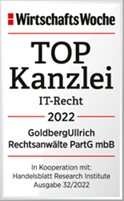The I Civil Senate of the Federal Court of Justice, which is responsible inter alia for trade mark and competition law, ruled on 23 September 2015 that the distribution by Lindt of a chocolate figure in the shape of a bear wrapped in gold foil and provided with a red collar neither infringes Haribo's Goldbären trade marks nor constitutes an unfair imitation of its fruit gum products.
The applicant produces and distributes fruit gum products. The products it manufactures include so-called "Gummi Bears", which it calls "GOLD BEARS". It is the owner of the word marks "Goldbären", "Goldbär" and "Gold-Teddy" registered for sugar confectionery. The defendants distribute chocolate products. These include the "Lindt Gold Bunny" and, since 2011, a chocolate figure in the shape of a sitting bear with a red neck ribbon, also wrapped in gold foil, which they themselves call the "Lindt Teddy".
The plaintiff demands that the defendants cease and desist from distributing the bear-shaped chocolate figures wrapped in gold foil and asserts claims for information, destruction and assessment of damages. It is of the opinion that the challenged figures infringe its trade marks and constitute an unfair imitation of its gummy bears.
The action was successful at first instance. The Higher Regional Court (Oberlandesgericht) amended the first-instance ruling and dismissed the action. The Federal Supreme Court essentially dismissed the appeal against the court of appeal's decision.
The plaintiff has no claims for infringement of its trade mark rights under § 14 para. 2 nos. 2 and 3 MarkenG. It is true that the plaintiff's trade marks "Goldbär" and "Goldbären" are well-known trade marks in Germany and that the goods of the parties at issue are very similar. However, there is no similarity between the plaintiff's trade marks and the challenged product designs of the defendant for the assumption of a likelihood of confusion or a mental association.
If - as in the case in dispute - a word mark and a three-dimensional product design are opposed to each other, the similarity of the signs cannot result from a similarity in the sound or the image of the signs, but exclusively from a similarity in the semantic content. Only the word mark and the contested product shape are to be compared. However, the comparison of the signs does not include the shape of the products, in this case the applicant's gummy bears, for which the word mark is used. A similarity in meaning requires that the word mark is the obvious, informal and exhaustive designation of the three-dimensional shape from the point of view of the targeted consumers. In this context, the assumption of similarity of signs must be subject to strict requirements, because otherwise there would be a risk that a similarity of signs in the meaning of a word mark with a three-dimensional product shape would lead to a far-reaching monopolisation of product designs, which cannot be achieved with a figurative mark or a three-dimensional product shape mark, which must designate a certain product shape. It is not sufficient that the word mark is only one among several obvious designations of the product shape.
In the case in dispute, there is no similarity in the meaning of the signs. Not only the terms "Goldbären" or "Goldbär" can be considered for the designation of the Lindt products. Other designations such as "Teddy", "Schokoladen-Bär" or "Schokoladen-Teddy" are equally obvious. With regard to another figurative mark of the plaintiff, which shows a standing bear figure, there is also a lack of sufficient similarity between the signs and the defendant's chocolate figures wrapped in gold foil. The plaintiff cannot rely on the word mark "Gold Teddy" because the assertion of this mark constitutes an anti-competitive hindrance of the defendant within the meaning of § 4 No. 10 UWG. The plaintiff had this trade mark registered in the trade mark register only after it had become aware of the defendant's intention to sell the product.
The plaintiff also has no claims under competition law. The contested product shapes are not imitations of the plaintiff's products within the meaning of Sec. 4 No. 9 UWG because there is no sufficient similarity between the plaintiff's gummy bears and the defendant's chocolate figures.
Judgment of the BGH of 23.09.2015 - I ZR 105/14
Preliminary instances:
Cologne Regional Court Judgment of 20 December 2012 - 33 O 803/11
OLG Cologne Judgment of 11 April 2014 - 6 U 230/12
Source: Press release of the BGH
Goldberg Attorneys at Law 2015
Attorney at Law Michael Ullrich, LL.M. (Information Law)
Specialist lawyer for information technology law
E-mail: info@goldberg.de


